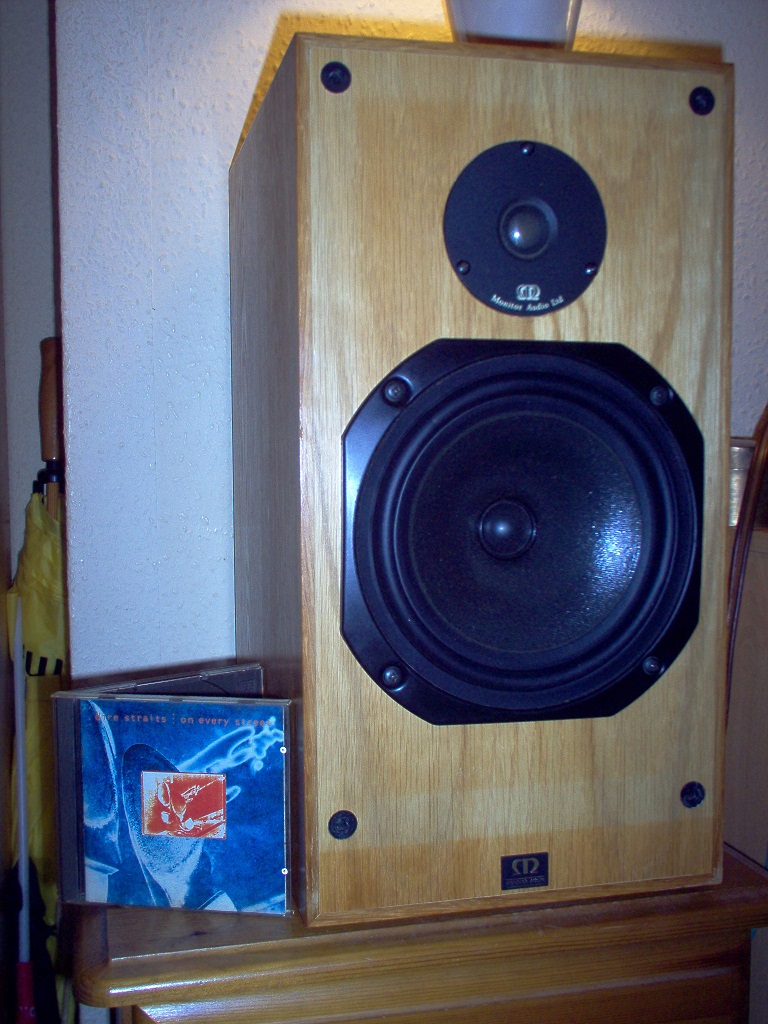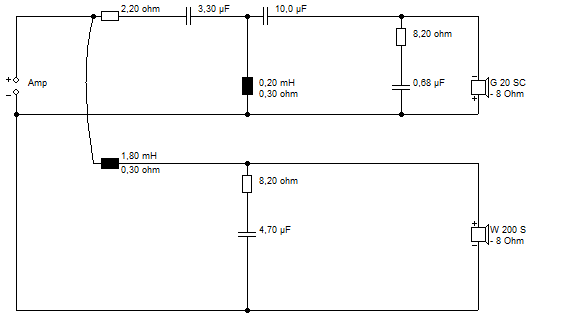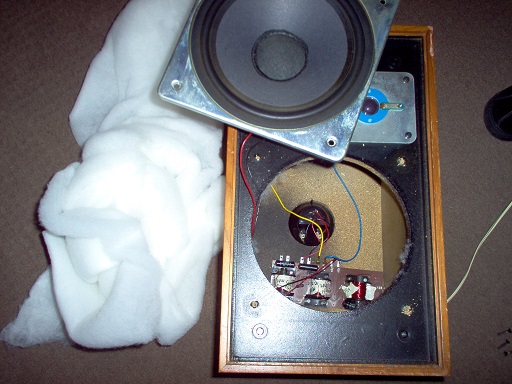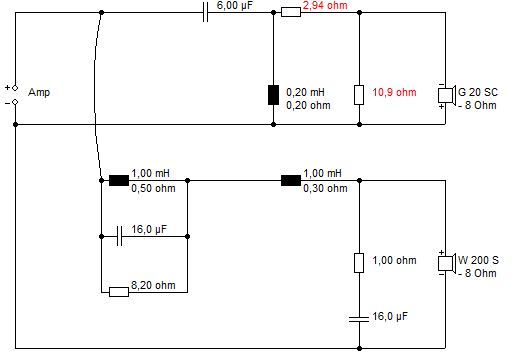I always listen to my current favourite. That used to be an 8" BW3 with a monacor cone tweeter.
But a recent thread where Robbintip said he has really heard nothing to compare with his SB26ADC metal domes made me rethink this.
http://www.diyaudio.com/forums/multi-way/325419-sb26adc-compared-sb29rdc.html#post5499050
I revived my SEAS 19TAF/G 3/4" AL domes with new ferrofluid. Lovely old closed box paper Elac woofers with 1" voicecoil and rubber dustcap.

Initially I did them BW3:

90 degree BW3 has good dispersion on three axes, but we all know that LR4 has lower distortion on axis. So that is what I tried next. Below.
Finally I tried simple second order tweeter on positive polarity as a sanity check. 6.8uF/0.2mH, as it goes. That was a woefully distorted tweeter sound even at 3kHz crossover. Sounded even worse with a soft dome.
All three versions are creditably flat frequency response, and work with almost any well behaved 8" bass, like SEAS and a few others make.
Where LR4 scores, is it never hits a bum note, as we used to say. Nothing leaps out. Nothing fatigues. Something you can turn up loud. FWIW, there ought to be a lot of 3kHz breakup from the bass, but I don't notice it. One of my better efforts I think.
But a recent thread where Robbintip said he has really heard nothing to compare with his SB26ADC metal domes made me rethink this.
http://www.diyaudio.com/forums/multi-way/325419-sb26adc-compared-sb29rdc.html#post5499050
I revived my SEAS 19TAF/G 3/4" AL domes with new ferrofluid. Lovely old closed box paper Elac woofers with 1" voicecoil and rubber dustcap.
Initially I did them BW3:
90 degree BW3 has good dispersion on three axes, but we all know that LR4 has lower distortion on axis. So that is what I tried next. Below.
Finally I tried simple second order tweeter on positive polarity as a sanity check. 6.8uF/0.2mH, as it goes. That was a woefully distorted tweeter sound even at 3kHz crossover. Sounded even worse with a soft dome.
All three versions are creditably flat frequency response, and work with almost any well behaved 8" bass, like SEAS and a few others make.
Where LR4 scores, is it never hits a bum note, as we used to say. Nothing leaps out. Nothing fatigues. Something you can turn up loud. FWIW, there ought to be a lot of 3kHz breakup from the bass, but I don't notice it. One of my better efforts I think.
Attachments
I always listen to my current favourite. That used to be an 8" BW3 with a monacor cone tweeter.
But a recent thread where Robbintip said he has really heard nothing to compare with his SB26ADC metal domes made me rethink this.
http://www.diyaudio.com/forums/multi-way/325419-sb26adc-compared-sb29rdc.html#post5499050
I revived my SEAS 19TAF/G 3/4" AL domes with new ferrofluid. Lovely old closed box paper Elac woofers with 1" voicecoil and rubber dustcap.

Initially I did them BW3:

90 degree BW3 has good dispersion on three axes, but we all know that LR4 has lower distortion on axis. So that is what I tried next. Below.
Finally I tried simple second order tweeter on positive polarity as a sanity check. 6.8uF/0.2mH, as it goes. That was a woefully distorted tweeter sound even at 3kHz crossover. Sounded even worse with a soft dome.
All three versions are creditably flat frequency response, and work with almost any well behaved 8" bass, like SEAS and a few others make.
Where LR4 scores, is it never hits a bum note, as we used to say. Nothing leaps out. Nothing fatigues. Something you can turn up loud. FWIW, there ought to be a lot of 3kHz breakup from the bass, but I don't notice it. One of my better efforts I think.
Nice job
I have a pair of KEF C30. They measure ruler flat but they muffle the midrange something chronic. My new 3 ways are nasty on some recordings but make others shine. the KEF's are more listenable on all, but my 3 ways more satisfying on some. The dilemma between listenable and accurate.
I still think my 3 ways are flawed and trying to find a solution to make bright / harsh recordings listenable. Take for example The Pretenders Greatest Hits. Brass in Pocket is awful on my 3 ways. Way to forward / bright at any level.
Your KEF C30 look a good project for improvement. Sort of thing I enjoy. 8" polypropylene polycone and 1" tweeter, probably soft dome, maybe mylar plastic.
The BW3 crossover I did in the previous post is below. 3kHz negative polarity, which is very KEF. Not hard to build, here with goodish 630V capacitors which help the very highest frequencies IMO. The 4th order conversion took little effort too. I just fitted a 0.3mH coil and a 6.8uF cap where the 10uF was.
I always like to come to some firm conclusions. Here that 3rd or 4th order is essential with lightweight 3/4" tweeters at 3kHz. Metal domes always used to be criticised for a hard metallic sort of sound, but I find the 7.5R/0.68uF Zobel tames it very well. Diffusors seem to do OK as well. The SEAS 19TAF/G has one built into the mesh. A disk of varnish which spreads the sound off-axis a little.
The LR4 is very good exactly on axis, the BW3 has a more spread out performance off-axis. A three way would do better on dispersion and loudness, of course. I know that sound well enough from owning enough of them.
I doubt that any speaker is going to do well with poor mixes though. Overly loud, compressed and bright is incureable. Pop music tends to this.
Without knowing anything about your 3 ways, it is hard to comment. But I like flattish and well behaved drivers for sure. Everything then just works with little effort.
The BW3 crossover I did in the previous post is below. 3kHz negative polarity, which is very KEF. Not hard to build, here with goodish 630V capacitors which help the very highest frequencies IMO. The 4th order conversion took little effort too. I just fitted a 0.3mH coil and a 6.8uF cap where the 10uF was.
I always like to come to some firm conclusions. Here that 3rd or 4th order is essential with lightweight 3/4" tweeters at 3kHz. Metal domes always used to be criticised for a hard metallic sort of sound, but I find the 7.5R/0.68uF Zobel tames it very well. Diffusors seem to do OK as well. The SEAS 19TAF/G has one built into the mesh. A disk of varnish which spreads the sound off-axis a little.
The LR4 is very good exactly on axis, the BW3 has a more spread out performance off-axis. A three way would do better on dispersion and loudness, of course. I know that sound well enough from owning enough of them.
I doubt that any speaker is going to do well with poor mixes though. Overly loud, compressed and bright is incureable. Pop music tends to this.
Without knowing anything about your 3 ways, it is hard to comment. But I like flattish and well behaved drivers for sure. Everything then just works with little effort.
Attachments
As much as the KEFs are easy to listen to, they just have a muddy midrange. I don't think the 8" woofer can provide the precision required and the tweeter probably won't want to cross low enough.
My 3 ways are aluminium woofer and midrange. The problem is the bright tweeter on certain recordings. Whether I crossover at 2.5Khz with 4+ acoustic order slopes or shallower makes no difference. It tells me the speaker is just being brutal at projecting what it is given.
I do like how the midrange and bass mix 2nd order acoustic. It's transparent (and a lot nicer on amplifiers not dipping below 4.3 ohms in the mid bass).
This all leads back to the original posters question... is +/- 3dB good enough? I'd say no. I think a speaker +/- 1.5dB is good enough - but consistently to at least a 30 degree listening angle, which will suit most listening environments.
My 3 ways are aluminium woofer and midrange. The problem is the bright tweeter on certain recordings. Whether I crossover at 2.5Khz with 4+ acoustic order slopes or shallower makes no difference. It tells me the speaker is just being brutal at projecting what it is given.
I do like how the midrange and bass mix 2nd order acoustic. It's transparent (and a lot nicer on amplifiers not dipping below 4.3 ohms in the mid bass).
This all leads back to the original posters question... is +/- 3dB good enough? I'd say no. I think a speaker +/- 1.5dB is good enough - but consistently to at least a 30 degree listening angle, which will suit most listening environments.
....The dilemma between listenable and accurate.
I still think my 3 ways are flawed and trying to find a solution to make bright / harsh recordings listenable. Take for example The Pretenders Greatest Hits. Brass in Pocket is awful on my 3 ways. Way to forward / bright at any level.
That's why every older JBL studio monitor had L-pad attenuators for tweeter and midrange. They didn't know what loudspeakers (or drugs) guys at the studio used while mixing, but they knew their loudspeakers were fairly flat and accurate. I'm tempted to use L-pad att's in my Kef R300 - i'm very reluctant to mess up the crossover in order to make it listenable on bad recordings.
Last edited:
When a basically nice 3-way sounds too clear, it might just be that the listener is used to typical "British" 2-way sound! KEF C30 represent the typical 80's 2-way when hardly anyone knew about power response and beaming of the 8" driver.
An externally hosted image should be here but it was not working when we last tested it.
Last edited:
OK, looks like no post argues that you can make the perfect speaker and it will always sound right. In other words, to make all recordings and locations (and FRs that aren't misleading near-field measurements) satisfactory, you need post-installment adjustment.That's why every older JBL studio monitor had L-pad attenuators for tweeter and midrange... I'm tempted to use L-pad att's in my Kef R300.
BTW, a certain logical conflict between those who want to hear a recording just as the engineer heard them* and those who want to critique the sound recorded by the crazy druggy who did a particular recording.
My own take - as someone who avoids pop recordings in favour of well-recorded "classical" music - is that I have no urge to again fudge my settings for a particular recording, once fine-tuning is complete (except for "loudness" compensation if playing late at night).
I thought it was part of audio-creed that a great installation plays everything right?
B.
*that's a slightly better thought-out spin of the naive "... just like Row H"
Last edited:
I think we are agreed that poor mixes are never going to sound good. All you can do is a bit of tonal adjustment to make them more bearable. We all know the BBC dip on tweeters, don't we? A rolled off treble.
The C30 was a cheap speaker. But a nice enough woofer by the look of it. Another Elac design, I reckon. Small voicecoil, which is a good thing IMO. Possibly not a million miles away from my own paper woofer.
Being a polycone, it doubtless has more natural rolloff at 3kHz, which might account for a recessed midrange. Largely fixable by less shunt damping in the crossover IMO.
No good moaning about it. Time to fix it. A metal tweeter would be good, I reckon. They have come on. This diyaudio, we have enquiring minds and a willingness to roll our sleeves up and get stuck in. What's the filter?
The C30 was a cheap speaker. But a nice enough woofer by the look of it. Another Elac design, I reckon. Small voicecoil, which is a good thing IMO. Possibly not a million miles away from my own paper woofer.
Being a polycone, it doubtless has more natural rolloff at 3kHz, which might account for a recessed midrange. Largely fixable by less shunt damping in the crossover IMO.
No good moaning about it. Time to fix it. A metal tweeter would be good, I reckon. They have come on. This diyaudio, we have enquiring minds and a willingness to roll our sleeves up and get stuck in. What's the filter?
When a basically nice 3-way sounds too clear, it might just be that the listener is used to typical "British" 2-way sound! KEF C30 represent the typical 80's 2-way when hardly anyone knew about power response and beaming of the 8" driver.
An externally hosted image should be here but it was not working when we last tested it.
I think you're onto something. We A/B switched back from the 3-way to the KEF C30 and both smiled. The detail was lost, the instrument separation gone. All we had was a "mash up" of sound (best way I can describe it). It was if someone put a pillow over the speaker, but it was worse.
I think we are agreed that poor mixes are never going to sound good. All you can do is a bit of tonal adjustment to make them more bearable. We all know the BBC dip on tweeters, don't we? A rolled off treble.
The C30 was a cheap speaker. But a nice enough woofer by the look of it. Another Elac design, I reckon. Small voicecoil, which is a good thing IMO. Possibly not a million miles away from my own paper woofer.
Being a polycone, it doubtless has more natural rolloff at 3kHz, which might account for a recessed midrange. Largely fixable by less shunt damping in the crossover IMO.
No good moaning about it. Time to fix it. A metal tweeter would be good, I reckon. They have come on. This diyaudio, we have enquiring minds and a willingness to roll our sleeves up and get stuck in. What's the filter?
My first issue is the KEF's aren't mine. They belong to my partner. Ok it's all shared property but she had them prior to our relationship and I don't think me replacing bits and pieces would be appreciated.
Even if she was ok with me DIY'ing them, I don't think I could without possibly making them too revealing of the source material.
As others have stated - they are largely a compromise design. A bass oriented woofer which won't do midrange better than a midrange specific driver.
Finding a tweeter happy to cross over low enough to help with beaming issues and take on enough midrange duty will be hard (without very steep crossover slopes).
Pah, excuses, excuses... but always inaction. Engineers fix things. 
Sounds like a pillow is over them, well KEF weren't that incompetent. Are the tweeters working?
30 years old with a derivative of the T33 tweeter. Those were ferrofluid IIRC. No.1 suspect. Probably gone solid.
Sounds like a pillow is over them, well KEF weren't that incompetent. Are the tweeters working?
30 years old with a derivative of the T33 tweeter. Those were ferrofluid IIRC. No.1 suspect. Probably gone solid.
Pah, excuses, excuses... but always inaction. Engineers fix things.
Sounds like a pillow is over them, well KEF weren't that incompetent. Are the tweeters working?
30 years old with a derivative of the T33 tweeter. Those were ferrofluid IIRC. No.1 suspect. Probably gone solid.
Ah yes good point on the ferrofluid. I think you're on the money there. Both tweeters work but probably have "seized" somewhat as we've both noticed a dulling in response. Is fluid replacement possible or is it simply easier to model a tweeter replacement?
Ferrofluid is very easy to replace if the tweeter comes apart easily. Get the old dried up goo out with a kitchen roll and maybe some aerosol spray like the UK favourite WD40.
I don't know where you can buy it in NZ, but parts Express in the uS and Blue Aran in the UK have it:
Sonitus Audio Ferro Fluid (ferrofluid) for Speakers and Compression Drivers 0.5ml from Sonitus Audio PS4.99 IN STOCK (21 Aug 2018)
That's what I use. About 0.1mL per tweeter. Doesn't matter much if you overdo it. More you use, the smoother the tweeter sounds.
If you take them apart, you'll see the problem. It's meant to be a black oily liquid, but the kerosene dries out leaving a solid gunge of iron oxide particles. Kills the tweeter response.
No reason why you can't run the tweeters without it for a while. They'll just sound brighter.
I don't know where you can buy it in NZ, but parts Express in the uS and Blue Aran in the UK have it:
Sonitus Audio Ferro Fluid (ferrofluid) for Speakers and Compression Drivers 0.5ml from Sonitus Audio PS4.99 IN STOCK (21 Aug 2018)
That's what I use. About 0.1mL per tweeter. Doesn't matter much if you overdo it. More you use, the smoother the tweeter sounds.
If you take them apart, you'll see the problem. It's meant to be a black oily liquid, but the kerosene dries out leaving a solid gunge of iron oxide particles. Kills the tweeter response.
No reason why you can't run the tweeters without it for a while. They'll just sound brighter.
You can get ferrofluid from here Great deals from QUEENSLAND SPEAKER REPAIRS in Ferro-Tec-Ferro-Fluid-KIts- | eBay Stores
cheers, Arthur
cheers, Arthur
Ferrofluid is very easy to replace if the tweeter comes apart easily. Get the old dried up goo out with a kitchen roll and maybe some aerosol spray like the UK favourite WD40.
I don't know where you can buy it in NZ, but parts Express in the uS and Blue Aran in the UK have it:
Sonitus Audio Ferro Fluid (ferrofluid) for Speakers and Compression Drivers 0.5ml from Sonitus Audio PS4.99 IN STOCK (21 Aug 2018)
That's what I use. About 0.1mL per tweeter. Doesn't matter much if you overdo it. More you use, the smoother the tweeter sounds.
If you take them apart, you'll see the problem. It's meant to be a black oily liquid, but the kerosene dries out leaving a solid gunge of iron oxide particles. Kills the tweeter response.
No reason why you can't run the tweeters without it for a while. They'll just sound brighter.
Thanks Steve - appreciated. Will take them out and see if I can get the faceplate off to have a look. Will take some photos!
You can get ferrofluid from here Great deals from QUEENSLAND SPEAKER REPAIRS in Ferro-Tec-Ferro-Fluid-KIts- | eBay Stores
cheers, Arthur
Thanks Arthur. Didn't know about that ebay seller. HAndy store / link to have. Appreciated.
A little summary on the "How Speakers Work" lines. This might save breaking anything.
Tweeters are usually screwed or clipped together. Occasionally the wiring is awkward and needs unsoldering at the terminals for disassembly. It is important to lift the voicecoil off vertically to avoid bending anything.
Below is one of my SEAS 19TAF/G tweeters. It comes apart easily with three plastic spring clips, which are easily manipulated with a small screwdriver. The magnet is tough as old boots, so shouldn't present a problem for cleaning out the gap. Good ferrofluid looks like a black rubberband sitting in the gap, held by magnetism.
The most popular "upgrade" for beginners at diyaudio is always replacing electrolytic capacitors as in the rather good Wharfedale Shelton XP2:

In fact I have never found any that don't work OK even after many years. IMO, this type of upgrade is a waste of time, but I can't prove it.
I like to look at the crossover. I worked out the XP2 has this:

A very good and interesting circuit, which KEF used a lot too. It's why the XP2 is rather good.
Capacitor quality has little effect on measured frequency response, or at least, nothing you can't compensate with a little resistance. Where cheap electrolytics are measureably different is on the overall impedance plot of a tweeter circuit, which can change by an ohm or two. I wish I had time to do some thorough measurements, especially with cheap MKP versus expensive ones, because everybody else has come up with zip on this capacitor quality issue. They've been measuring the wrong thing.
Tweeters are usually screwed or clipped together. Occasionally the wiring is awkward and needs unsoldering at the terminals for disassembly. It is important to lift the voicecoil off vertically to avoid bending anything.
Below is one of my SEAS 19TAF/G tweeters. It comes apart easily with three plastic spring clips, which are easily manipulated with a small screwdriver. The magnet is tough as old boots, so shouldn't present a problem for cleaning out the gap. Good ferrofluid looks like a black rubberband sitting in the gap, held by magnetism.
The most popular "upgrade" for beginners at diyaudio is always replacing electrolytic capacitors as in the rather good Wharfedale Shelton XP2:
In fact I have never found any that don't work OK even after many years. IMO, this type of upgrade is a waste of time, but I can't prove it.
I like to look at the crossover. I worked out the XP2 has this:
A very good and interesting circuit, which KEF used a lot too. It's why the XP2 is rather good.
Capacitor quality has little effect on measured frequency response, or at least, nothing you can't compensate with a little resistance. Where cheap electrolytics are measureably different is on the overall impedance plot of a tweeter circuit, which can change by an ohm or two. I wish I had time to do some thorough measurements, especially with cheap MKP versus expensive ones, because everybody else has come up with zip on this capacitor quality issue. They've been measuring the wrong thing.
Attachments
Last edited:
...This all leads back to the original posters question... is +/- 3dB good enough? I'd say no...
Just because you can form a nice scientific sounding sentence with words like "+/- 3dB" it doesn't mean it actually is saying something meaningful.
You can only say that if you are talking eyeballs, not ears. Unsmoothed FRs are wild. What you mean is "when I look at an FR with a certain specified degree of eyeball smoothing...". Your ears don't do smoothing. (Well, they have perception "bands" but that is very different notion and nobody so far in this thread has the sophistication to talk in those terms.)
Another issue - as you carry your perfect +/- 3dB speaker from the anechoic chamber into your room - is that the bass (and other pi radiation) can not be defined except in relation to the ground plane*. So again, easy to sound oh-so-scientific and yet be saying things that are without rigour.
Sorry Dave Bullet, didn't mean to single you out.
B.
*ignore this point if you are playing music in outer space
Last edited:
I still think in an anechoic chamber a speaker that itself has a +/- 3 dB response is bad. That's before you take room effects into account. Don't you think a speaker that is amplitude and phase accurate without cabinet resonance is the goal so it doesn't impart its own signature?
- Status
- This old topic is closed. If you want to reopen this topic, contact a moderator using the "Report Post" button.
- Home
- Loudspeakers
- Multi-Way
- Crossover: Staying within 3dB






